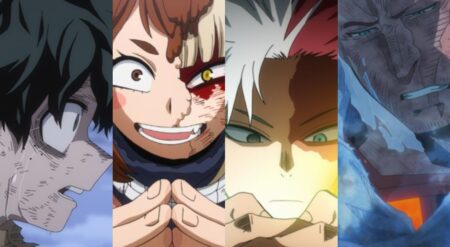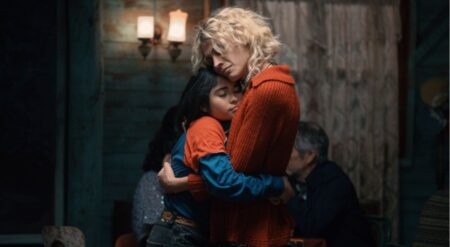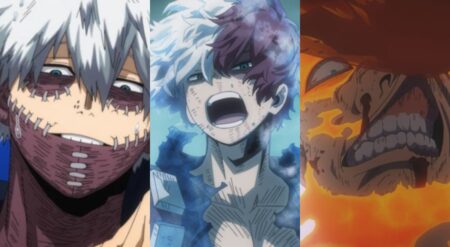When people think of Texas they think of white cowboys, white pageant girls, and the whiteness that drives our politics. But when you live here, you see the diversity of the vast state, and how many Mexican communities created Texas to become what it is today. I’m Tejana, which means that I am Mexican-American but specifically that my family has, well, always been here. Often, I don’t see my face in stories about Texas, or the way the trials we face in this state have created a deep-running resiliency in our communities. Whether Tejano or immigrant, the border towns of Texas, South Texas is a unique experience of beauty and grit that you have to see to understand. In comes Ana Flores.
I never thought I would write that opening to lead into a feature about an asymmetrical horror game, but here I am. Thanks to GUN Interactive and Sumo Digital Ltd., The Texas Chain Saw Massacre is a love letter to the Mexican communities of Texas and their resilience in a way that you wouldn’t expect through Ana and Maria Flores.
I got the chance to talk with Creative Director Ronnie Hobbs about creating Ana and Maria, two Mexican-American sisters from Uvalde, Texas, about the importance of representing South Texas in the game. After the massacre in Uvalde, GUN made the decision to keep Ana and Maria’s origin. And while you can say making them the victims in a horror game isn’t the best optics, the truth is that Ana’s resiliency as a playable character is one that offers a unique look at identity being taken into account for character mechanics.
Ana Flores has been through the wringer, and there is no way one hit brings her down. Instead, she is a tank, she takes the most damage of any character, and as Hobbs explained, that’s purposeful because of the women he met in Uvalde and across the Mexican communities in South Texas.
“[Ana] is high damage, because of her upbringing. I have a really great story about how Ana and Maria came to even be. Ana’s sister Maria is who brings the Family together…Maria is this art student, and they’re from Uvalde, they’ve had worked hard, their dad is gone. Just like a lot of kids who are first-generation kids from maybe Mexico or anywhere in South America, they work hard. I went to Bandera and Medina and Uvalde. I went probably, I don’t know, maybe three or four trips around Texas just visiting hundreds of small towns and talking to people looking for the perfect home for Ana and Maria. But I couldn’t find it.”

He continued, “Then one day after Medina and Bandera I stumbled upon Uvalde and it just felt like home. This was a year and a half before anything happened. I was talking to these young girls there they were working in a Rexall’s Drug Store—of all places—and their story [was one that] I kept hearing. It was the same story about just having to help work and pay their mother and just help [their family]. And it’s the same when we don’t grow up rich, right? You have to struggle for everything. That kind of led me to make Ana tough because I could see it in this girl that I was talking to. [She was talking] about how hard she was working supporting her mom, because their dad wasn’t around anymore, and she had a sister that was also working. And I kept hearing that story repeatedly. So I was like, ‘Okay, this is home.’ So once I found the home for the characters…I don’t know the percentage of the population of people that came from Mexico, but it’s very, very large.”
And Hobbs is right. Uvalde is 72 percent Latino, the majority of which is Mexican-American, in line with other Southern cities in the state. And while these are populations built on immigration, it’s not in the way that you may only think. From first to ninth generation and beyond Southern Texas is filled with small towns that were created and thrived by the hard-working Mexican communities that live there. To see this recognized in a horror game? Well, I didn’t know how much it would impact me, but it did.
As I took time after the Technical Test and this interview to digest exactly why Ana Flores was so important, it hit me. Her character, her hometown, and her situation use the legacy of resiliency that I know to be emblematic of my culture. It’s how I was raised, and to see it worked into her beyond just the surface? Well, it’s strella. Ana didn’t just have a Mexican name, or a voice that sounded like the people I grew up with. She was crafted by learning about my state, about my people, and that is a central focus of the game’s narrative and even its marketing.
In fact Ana’s Star Sign, “Pain is Nothing” is a defining characteristic that is immediately recognizable to me. Pain is nothing because life is hard, and when life is hard you don’t have time to feel the moments of shock and trauma that happen to you. That’s what has happened to me repeatedly in my life and on my worse days when I call my mom for support, it’s what she tells me. Ana is a “high damage” character, because when life has thrown so much at you, are you going to get caught by Leatherface or are you going to jump out a window and make sure you survive?
Ana’s inclusion as the driving narrative force for the lore The Texas Chain Saw Massacre was a thoughtful way for GUN to show players Texas the way I know it to be. Talking about his trips to South Texas, Hobbs continued, “I’d never been to that specific part [of Texas]. Yeah, I was like, ‘Oh, this is perfect!’ It’s a rugged but beautiful place built by hardworking people, and that’s kind of where Ana Flroes got her traits and her abilities from, but it was really important that I wanted Ana and Maria in the game because I wanted to represent that culture. A lot of people, when they think of Texas, they don’t think about that. If you don’t go below Austin, or sometimes you don’t see that, like San Antonio or all of the cities close to the border, and all close to West Texas…That was lovely.”
This representation of Texas the way Tejanos know it to be, even goes into Ana’s voice lines. Hobbs explained, “Even with her voice lines, we did a lot of research on trying to make it authentic. And a lot of that was just me paying attention to what they were saying. So and then trying to remember it and write these things down and do as much research too because even her clothes, we found antique shops with clothes that were hand embroidered from just tons of generational pass downs from grandmothers and mothers…”
Now that The Texas Chain Saw Massacre is out in the wild, I hope that people fall in love with Ana Flores, as much as I have. I hope she stands as a testament to Latino resiliency, and how Tejanos have thrived and survived in conditions in our states that should have crushed us. Pain is nothing.
The Texas Chain Saw Massacre is available now with crossplay on PlayStation 5, PlayStation 4, Xbox One, Xbox Series X and Series S, and PC.






![[EXCLUSIVE] ‘Invincible VS’ Devs Dive Deep Into Their New Original Character: Ella Mental Ella Mental in Invincible VS](https://butwhytho.net/wp-content/uploads/2025/12/Invincible-VS-Ella-Mental-But-Why-Tho-1-450x247.jpg)
![[EXCLUSIVE] Palia Devs Dive Into Winterlights, New Tints, Lunar Paths, And More From Upcoming Patch Palia Winterlights Patch](https://butwhytho.net/wp-content/uploads/2025/12/Palia-Winterlights-But-Why-Tho-450x247.jpg)